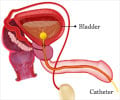A simple fluorescent light test would soon make it possible for people to have an almost instantaneous diagnosis for urinary tract infections and that too at home.
Developed by Macquarie University researchers, this unique fluorescence test holds the potential to provide warnings about the presence of other disorders and diseases including cancer.According to researcher Professor Ewa Goldys, of the university's Department of Physics, the research could lead to a home diagnosis kit that uses simple technology now available.
She pointed out that the impact of urinary tract infections is underestimated till date. Causing about 60 in 1000 patient consultations annually, UTIs are estimated to account for 30 to 40 percent of all hospital-acquired infections.
In the study, the researchers analysed 70 urine samples and found that there exists a clear variation in the fluorescence levels at certain wavelengths in normal and bacteria-infected urine.
They said that this difference is caused due to the presence of bacteria that makes the body to respond by increasing levels of the enzyme indoleamine dioxygenase (IDO), which aids in fighting off infection by reducing levels of tryptophan, an amino acid that promotes microbial growth.
Goldys said that even though urinary tract infections can be easily treated with antibiotics, there needs to be a rapid and inexpensive form of diagnosis to avoid the condition to deteriorate further.
Advertisement
"The physiology that we believe is actually behind this is also present in many other conditions. It's about the activation of the immune system. The immune system begins to attack the disease and induces the same enzyme to be released," ABC Online quoted Goldys, as saying.
Advertisement
"We are not looking for the elephant in the room, but for evidence of the presence of the elephant," he said.
He added that under this test, the "evidence of the elephant" is the body's response to the presence of bacteria. And even though the research is very preliminary the "potential of this is enormous".
Goldys further said that in the long run, home kits based on the fluorescence test may act as an early alarm to warn people to go and see a doctor, as soon as possible. However, she said that the research is in its "early stages" and has involved a small sample.
"We don't want to make any pronouncements, but we are on a bit of a trajectory and can see the potential ... we like dreaming here," she said.
The study was presented at the recent 21st Congress of the International Commission for Optics held in Sydney.
Source-ANI
RAS/L















